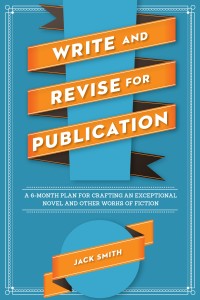Guest Post by Jack Smith
Revising a novel often calls for a bit of pruning. Some material must undoubtedly go, anything that doesn’t contribute pretty directly to the plot and your protagonist’s overall arc. If it’s material you feel pretty ho-hum about, good—it’s gone. You’re happy to see it go. But if you feel really invested in it, and you’ve done a lot of work on it, then cutting it can be something of a heart-breaker. You hesitate. Should you?
What kinds of material? The following are some candidates for pruning:
- Characters who are rather peripheral to the plot, or to your protagonist’s overall arc. These characters might be quite compelling, with interesting links to other characters. Their dialogue might be scintillating. They might contribute in some way to a particular setting. All to the good. But . . . however interesting they are, however much time you spent in trying to make them interesting, however much you worked and re-worked the descriptive details that make them alive in word and gesture, they’ve got to go. Unless you can broaden the scope of your novel. That’s, of course, a possibility, but ask yourself: What is the new unifying principle? What is my plot now? How long is this going to make my novel?
- Scenes that are overlong, cause repetition, or they’re too tangential. These scenes might do all a scene should do: include lively dialogue, spark conflict, relate to key conflicts in the work, and introduce or advance a thematic idea or two. The setting details might be quite vivid. But as it is, they’re rather repetitive of other scenes, and a few of them are a bit off track, plot-wise. They get your novel in the weeds a bit. Summary would probably work better instead of these scenes—perhaps summary with a few half-scenes to pull the reader in. But it’s going to be painful to part with these splendid scenes. Must you really? You’ve spent hours and hours at refining them. Perhaps the reader won’t even notice the repetition . . . the only thing is, you are beginning to notice the repetition yourself. And so . . .
- Certain subplots. Perhaps these plot threads thicken things up. But, as with other candidates for the shears, they seem to sidetrack the reader too much. Maybe if you were to write a considerably longer novel, they would work. But that might mean going way over 100,000 words, and that’s not too advisable if you seek publication. Well . . . and so . . .
When you get into the thick of novel revision, you’ll probably face a bit of necessary pruning, perhaps cutting some very good stuff. But don’t just dump it; save it for future novels. And it is possible that once you’ve done the pruning, you’ll actually be glad you did it. It’s no fun to snuff out good characters, of course. You’ve come to know them like real people. It’s also hard to scrap scenes that feel vibrant and alive. And interesting subplots—who wouldn’t hate to give them up? They could be intriguing to pursue. But any material that takes your novel off course, save it for another novel to save your present novel.
Jack Smith is author of the novel Hog to Hog, which won the George Garrett Fiction Prize (Texas Review Press. 2008), and is also the author of Write and Revise for Publication: A 6-Month Plan for Crafting an Exceptional Novel and Other Works of Fiction, published earlier this year by Writer’s Digest. His novel ICON was published in June by Serving House Books.
Prize (Texas Review Press. 2008), and is also the author of Write and Revise for Publication: A 6-Month Plan for Crafting an Exceptional Novel and Other Works of Fiction, published earlier this year by Writer’s Digest. His novel ICON was published in June by Serving House Books.
Over the years, Smith’s short stories have appeared in North American Review, Night Train, Texas Review, and Southern Review, to name a few. He has also written some 20 articles for Novel & Short Story Writer’s Market, as well as a dozen or so pieces for The Writer.He has published reviews in numerous literary journals, including Ploughshares, Georgia Review, Missouri Review, Prairie Schooner, American Review, Mid-American Review, and the Iowa Review.
Ugh, yes, don’t I know all of the above. My problem is often the opposite–a first draft will barely hit 40k. I have to pad out the story, without adding superfluous scenes, characters, etc. It’s equally tricky. Like cooking a delicate dish with just the right seasonings.
Cutting out a subplot is the most difficult.
I wrote the ending to my last novel first (only time I’ve ever done that) and once I finally had the outline hammered out, I realized it didn’t fit. So I scrapped it.
The only way to solve the problems you identify is for the writer to have his/her work critiqued by reliable readers/editors (the operative word being “reliable”). After all, the writer doesn’t set out to develop superfluous characters, overlong scenes or unnecessary subplots. The only alternative is for the writer to gain distance from the work through the passage of time. But that takes you-know-what, and who’s got enough of it?
Hi Elizabeth and Jack … relooking at our work and cutting it down is an art – and I’m sure one we could all learn … I know I don’t do enough of it ..
Thanks for the guidelines .. cheers Hilary
Thanks, everyone!
Pruning is heaps of fun :-/ Got mine down from 120,000+ words to a little under 55,000. I can almost hear my MS’s stomach rumbling :-D
any material that takes your novel off course, save it for another novel to save your present novel, Thanks Jack, that’s not something I’d thought about.